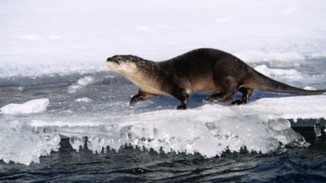
未来水獭皮潜水服会更加温暖
Future Wet Suits Otter Be Warmer
未来水獭皮潜水服会更加温暖(用水獭皮制作更温暖的潜水服)
Future wet suits with surface textures like the thick fur of otters that trap insulating air layers could keep tomorrow’s divers warmer in icy waters.
未来潜水服的表面材质或将模拟厚实且附有空气隔离层的水獭毛发,这将帮助将来的潜水员更好地在冰水中保温。
撰文/播音:辛西娅·格雷伯(Cynthia Graber)
翻译:郭鑫鹏
审校:吴非
Whales, seals and walruses stay warm in chilly water because they have a thick layer of blubber. We humans rely on something like blubber—neoprene rubber wet suits-to spend time in cold water. But the thick versions for really icy water are heavy and ungainly. So rather than taking after big marine mammals, what if we could learn from the littler ones, like beavers and otters?
因为厚实的脂肪层,鲸鱼、海豹和海象在寒冷的水中依然可以保持温暖的体温。依靠与脂肪层功能相似的氯丁橡胶潜水服,我们人类也可以在寒冷水下活动,但是这类衣服对于真正冰水条件就显得过于沉重和笨拙。所以,既然无法效仿那些大型海洋哺乳动物,我们是否可以从小型动物,如河狸和水獭身上学到些什么?
“These animals are quite small and they can’t carry around a thick layer of blubber. So instead they have fur that is evolved to trap air, and this air provides a layer of insulation for them in water.”
“这些动物非常小,身上没有厚脂肪层,但它们的毛发经演化可以存储空气。在水中,这部分空气起着隔离层的作用。”
Alice Nasto is a graduate student in mechanical engineering at MIT. Scientists have known about this air-trapping insulation mechanism for a long time, but they had not teased out the details of how it works. So Nasto and her colleagues took on the challenge.
艾丽斯·纳斯托是麻省理工学院机械工程专业的研究生。科学家很久以前就已经知道这种空气存储隔离机制,但是他们一直没有弄明白其中的原理。所以,纳斯托和她的同事们接受了这个挑战。
“We’re creating these furry samples from these rubbery materials by laser cutting molds and casting these hairy surfaces. And through our approach we can precisely control the spacing of the hairs [and] the length of the hairs.”
“利用激光切割模具,我们用橡胶材料制造这些带毛的样本,并铸造毛茸茸的表面。经过尝试,我们可以精确地控制毛发的疏密和长度。”
The researchers then created a system to gather data when their pelts entered and moved through a liquid-in this case not water, but silicone oil, which makes it easier to see air bubbles. The key is to keep the pelt’s air layer intact.
研究人员接着设计了一个系统,用于收集这些毛皮进入液体、在液体中移动时的数据。在这里,研究人员使用的液体并不是水,而是硅油,这样更易于观察气泡。实验的关键是保证毛皮的空气层完好无损。
“So when they’re crossing the air water interface, initially their hairy texture is full of air. And then you go into water. How much of the air comes down with you as you’re moving in through the interface. So that’s what this model will tell you.”
“当它们穿过空气与水的分界面时,最初这些毛绒材质中充满了空气。在你进入水中后,有多少空气随着你一起进入水中,这便是这个模型能够告诉你的东西。”
They found that the denser the hairs, the more the air gets trapped. Which should keep the animal-or potentially the human in a future furry wet suit-warm. The research is in the journal Physical Review Fluids. [Alice Nasto et al., Air entrainment in hairy surfaces]
他们发现,毛发越密集,捕捉的空气也越多,这会对动物和未来使用这种毛绒潜水服的人起到保温作用。这项研究发表在《流体物理评论》(Physical Review Fluids)上。[Alice Nasto et al., Air entrainment in hairy surfaces]
“What we would like to work on moving forward is understanding how, after you dive into the water, how do you maintain this air layer trapped in you fur. And there’s lots of interesting properties of the fur in nature that we haven’t yet looked at in our model that could help explain how this mechanism might work.”
“我们接下来想要研究的是,当你潜入水中后,如何维持毛皮中的空气层。这种毛皮还隐藏着许多我们尚未进行测试的有趣特性,这些可以帮助我们更好地理解其工作机制。”
So for now, cold-water divers and surfers will still emulate seals or sea lions. But the day may come when they’ll more closely resemble otters or beavers. Or even a Wookiee on a boogie board.
现在,冷水潜水员和冲浪运动员依然使用模仿海豹和海狮的服装,但在将来,他们有可能会穿上像河狸和水獭一样的服装,甚至变成如冲浪板上的伍基人一般。(注:伍基人是《星球大战》中的种族,毛发浓密)
未经书面许可任何人不得复制或镜像
京ICP备11000850号-1
 京公网安备11010502039775号
京公网安备11010502039775号 信息网络传播视听节目许可证0111611号
国家科技基础条件平台

















